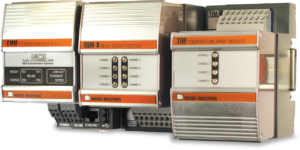Moore Industries Net Concentrator System (NCS) is the ideal real-time signal gateway from your field instruments, process sensors, and final control elements to your BPCS and control strategy. NCS networks are made up of one or more stand-alone I/O stations consisting of one EMM Ethernet/MODBUS Interface Module, combined with Input and/or Output Modules. Any combination of Input and Output Modules may be used within a NCS network. While the NCS is typically employed for peer-to-host or peer-to-peer remote I/O applications in harsh environments, its ability to handle simple and multi-point alarming applications helps protect critical assets or personnel.
With the Multipoint Analog Alarm (–MAA) option, setting up simple or dynamic alarming schemes with the NCS becomes quick and easy. The -MAA option utilizes a built-in ISaGRAF program which provides a flexible alarm configuration that is accessed with easy-to-use web pages through an on-board web server, with no PLC programmer required.
A full NCS station with the -MAA option can have as many as 60 inputs, 32 alarms and eight physical relay outputs. The 32 alarms can be assigned to any of the eight relay outputs so that each relay output can be driven by one alarm or multiple alarms. In addition, all alarms can be configured as high or low with their own deadband setting and can optionally include alarming on any NCS system faults.
All alarming functionality is implemented within the NCS station and is local to the process. If you want to share all that data with a SCADA, RTU or other host system you can do so with the three independent communications ports. The NCS has two RS-485 ports that support MODBUS RTU and an Ethernet port that supports MODBUS/TCP. The -MAA alarm functionality is not dependent upon communications back to a host, so its integrity is high.

Figure 1. A basic NCS station for use with the -MAA option.
Figure 1 shows a basic physical configuration of hardware to implement multipoint alarming. The Ethernet MODBUS/Interface Module (EMM) is the communication module retrieving process data from connected input modules, executing the alarm functions and writing the alarms to the relays, while also providing the MODBUS communications back to optional host. The Relay Output Module (ROM) used by the -MAA is always in Module position #1. The ROM has eight relays with 2A contacts, either NO or NC. The Temperature Input Module (TIM), which can measure inputs like thermocouples, RTDs, mV, resistance, and potentiometers is also a member of this basic configuration.
If the TIM is not appropriate for your application you might use the Analog Input Module (AIM), which powers and measures transmitter currents and other voltage inputs. For alarm purposes you may be using points from a TIM, AIM, or Analog Output Module (AOM). The NCS’s modular design allows any combination of Input and Output Modules to be matched with an Interface Module. To accommodate changing site requirements, I/O Modules can be added or removed from the NCS, and additional stations can be added to a network at any time. With this modular approach, the NCS can handle a wide range of signal inputs and outputs, which include current, voltage, relay, RTD, discrete, thermocouple, resistance, or potentiometer.

Figure 2. NCS Alarm System for HPumps
Figure 2 shows an effective application of the NCS alarming capabilities for the early detection of temperature excursions in HPump system motors that are used in oil and gas operations to meet a variety of pumping needs. If temperature excursions are not caught early on in these system motors, extensive damage to HPump components such as front and rear bearings, windings, and thrust bearings can occur. These repairs are very costly and can also impact production, which leads to even greater expense. The NCS with its configurable -MAA alarm capability that provides relays for warnings or trip functions is an effective monitoring and alarm solution for these HPump system motors because it can alert the production staff of temperature excursions early on to help prevent damage and production downtime.
The NCS’s flexibility allows you to create new monitoring and control networks, as well as leave existing “legacy” sensors, analog instruments, and valves in place. Industrially hardened and configurable I/O stations mount throughout a site or in dispersed locations around the world to provide cost-effective data acquisition and control. With the NCS you can concentrate just a few, or hundreds, of process signals onto a single digital data link, thereby saving the cost of cable, conduit, connection, and wire tray costs for hard wiring your field devices back to your BPCS. The NCS also boasts superior 20-bit input and 18-bit output resolution, an ambient temperature operating range of -40°C to +85°C, isolation and RFI/EMI protection, and logging of up to 64,000 time-stamped data points.
Click here to download Datasheet.
Click here for HPump application.
Moore Industries is a world leader in the design and manufacture of exceptionally rugged, reliable and high-quality field and DIN rail mounted instrumentation for the process monitoring and control industries, providing first-rate service and solutions for the chemical, petrochemical, utilities, petroleum extraction, refining, pulp and paper, food and beverage, mining and metal refining, pharmaceuticals, and biotechnology industries.
Call Moore Industries today at 44 (0)1 293-514488
 Instrumentation Monthly Test | Measurement | Control
Instrumentation Monthly Test | Measurement | Control